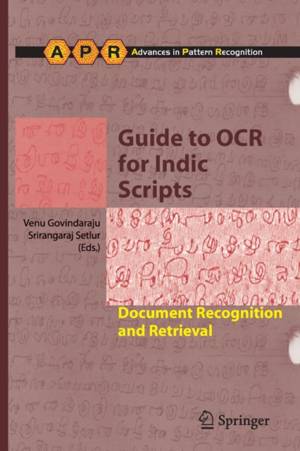
- Afhalen na 1 uur in een winkel met voorraad
- Gratis thuislevering in België vanaf € 30
- Ruim aanbod met 7 miljoen producten
- Afhalen na 1 uur in een winkel met voorraad
- Gratis thuislevering in België vanaf € 30
- Ruim aanbod met 7 miljoen producten
Zoeken
Guide to OCR for Indic Scripts
Document Recognition and Retrieval
€ 202,95
+ 405 punten
Omschrijving
Theoriginalmotivationsfordevelopingopticalcharacterrecognitiontechnologies weremodesttoconvertprintedtexton?atphysicalmediatodigitalform, prod- ingmachine-readabledigitalcontent. Bydoingthis, wordsthathadbeeninertand bound to physical material would be brought into the digital realm and thus gain newandpowerfulfunctionalitiesandanalyticalpossibilities. First-generation digital OCR researchers in the 1970s quickly realized that by limiting their ambitions primarily to contemporary documents printed in st- dard font type from the modern Roman alphabet (and of these, mostly English language materials), they were constraining the possibilities for future research andtechnologiesconsiderably. Domainresearchersalsosawthatthetrajectoryof OCR technologies if left unchanged would exclude a large portion of the human record. Digitalconversionofdocumentsandmanuscriptsinotheralphabets, scripts, and cursive styles was of critical importance. Embedded in non-Roman alp- bet source documents, including ancient manuscripts, papyri scrolls, clay tablets, and other inscribed artifacts was not only a wealth of scholarly information but alsonewopportunitiesandchallengesforadvancingOCR, imagingsciences, and othercomputationalresearchareas. Thelimitingcircumstancesatthetimeincluded the rudimentary capability (and high cost) of computational resources and lack of network-accessible digital content. Since then computational technology has advancedataveryrapidpaceandnetworkinginfrastructurehasproliferated. Over time, thisexponential decrease inthecost of computation, memory, and com- nicationsbandwidthcombinedwiththeexponentialincreaseinInternet-accessible digitalcontenthastransformededucation, scholarship, andresearch. Largenumbers ofresearchers, scholars, andstudentsuseanddependuponInternet-basedcontent andcomputationalresources. Thechaptersinthisbookdescribeacriticallyimportantareaofinvestigation- addressingconversionofIndicscriptintomachine-readableform. Roughestimates haveitthatcurrentlymorethanabillionpeopleuseIndicscripts. Collectively, Indic historic and cultural documents contain a vast richness of human knowledge and experience. The state-of-the-art research described in this book demonstrates the multiple values associated with these activities. Technically, the problems associated with Indicscriptrecognitionareverydif?cultandwillcontributetoandinformrelated v vi Foreword scriptrecognitionefforts. Theworkalsohasenormousconsequenceforenriching andenablingthestudyofIndicculturalheritagematerialsandthehistoricrecord of its people. This in turn broadens the intellectual context for domain scholars focusingonothersocieties, ancientandmodern. Digital character recognition has brought about another milestone in coll- tivecommunicationbybringinginert, ?xed-in-place, textintoaninteractivedi- talrealm. Indoingso, theinformationhasgainedadditionalfunctionalitieswhich expandourabilitiestoconnect, combine, contextualize, share, andcollaboratively pursue knowledge making. High-quality Internet content continues to grow in an explosivefashion. Inthenewglobalcyberenvironment, thefunctionalitiesandapp- cationsofdigitalinformationcontinuetotransformknowledgeintonewundersta- ingsofhumanexperienceandtheworldinwhichwelive. Thepossibilitiesforthe futurearelimitedonlybyavailableresearchresourcesandcapabilitiesandtheim- inationandcreativityofthosewhousethem. Arlington, Virginia StephenM.
Specificaties
Betrokkenen
- Uitgeverij:
Inhoud
- Aantal bladzijden:
- 325
- Taal:
- Engels
- Reeks:
Eigenschappen
- Productcode (EAN):
- 9781447125181
- Verschijningsdatum:
- 14/03/2012
- Uitvoering:
- Paperback
- Formaat:
- Trade paperback (VS)
- Afmetingen:
- 156 mm x 234 mm
- Gewicht:
- 485 g

Alleen bij Standaard Boekhandel
+ 405 punten op je klantenkaart van Standaard Boekhandel
Beoordelingen
We publiceren alleen reviews die voldoen aan de voorwaarden voor reviews. Bekijk onze voorwaarden voor reviews.







